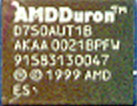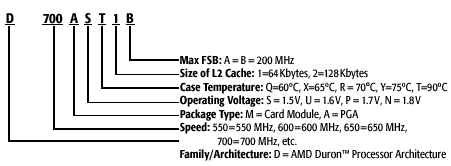The Chip
Since the first Duron 700 we reviewed had no problem overclocking all the way up to 900MHz, there is no reason that AMD would have to make any dramatic changes to their Duron core in order to allow it to hit 750MHz.

· 25 million transistor 0.18-micron Duron core with Aluminum interconnects
· 750MHz clock speed - 7.5x clock multiplier
· 128KB on-die L1 cache running at core speed
· 64-bit exclusive 64KB on-die L2 cache running at clock speed
· 462-pin Socket A EV6 CPU interface running at 100MHz DDR (effectively 200MHz)
· 1.60v core voltage
Our original Duron sample (700MHz) was a 1.60v part, but it seems as if AMD is shipping Durons rated at 1.5v as well as 1.6v. We received an OEM Duron 700 that had a 1.5v core voltage setting, but our most recent 750MHz sample was rated at 1.60v.


With the Thunderbird being rated at between 1.70 - 1.75v, it makes sense that as the Duron increases in clock speed, its core voltage will see a similar increase until it reaches the level of the Thunderbird since it is based upon the same core but with less L2 cache.
|
CPU
Specification Comparison
|
||||||||
| AMD Duron |
AMD
Athlon
|
Intel
Pentium III
|
Intel
Celeron
|
|||||
| Core |
Spitfire
|
K7
|
K75
|
Thunderbird
|
Katmai
|
Coppermine
|
Mendocino
|
Coppermine128
|
|
Clock Speed |
600
- 750 MHz
|
500
- 700 MHz
|
750
- 1100 MHz
|
450
- 600 MHz
|
500
- 1000 MHz
|
300
- 533 MHz
|
533
- 600 MHz
|
|
| L1 Cache |
128KB
|
32KB
|
||||||
| L2 Cache |
64KB
|
512KB
|
256KB
|
512KB
|
256KB
|
128KB
|
||
| L2 Cache speed |
core
clock
|
1/2
core
|
2/5
or 1/3 core
|
core
clock
|
1/2
core
|
core
clock
|
||
| L2 Cache bus |
64-bit
|
256-bit
|
64-bit
|
256-bit
|
||||
| System Bus |
100 MHz DDR (200 MHz effective) EV6
|
100
- 133 MHz GTL+
|
66
MHz GTL+
|
|||||
| Interface |
Socket-A
|
Slot-A
|
Socket-A
Slot-A (OEM only) |
Slot-1
|
Slot-1
Socket-370 |
Socket-370
|
||
| Manufacturing Process |
0.18
micron
|
0.25
micron
|
0.18
micron
|
0.25
micron
|
0.18
micron
|
0.25
micron
|
0.18
micron
|
|
| Die Size |
100mm^2
|
184
mm^2
|
102mm^2
|
120mm^2
|
128mm^2
|
106mm^2
|
153mm^2
|
106mm^2
|
| Transistor Count |
25
million
|
22
million
|
37
million
|
9.5
million
|
28
million
|
19
million
|
28
million
|
|
The Duron processors are still coming out of AMD's Fab25 facility in Austin, Texas since they are using Aluminum interconnects versus their high speed Copper counterparts being produced in the Fab30 plant in Dresden. It seems like Copper may be necessary for the Thunderbird/Duron core to reliably reach 1GHz and beyond, which could explain why we're only seeing 1GHz+ CPUs coming out of Dresden.
For now, all Durons are still using Aluminum interconnects and are thus being produced in AMD's Fab25 plant.










0 Comments
View All Comments